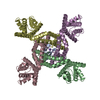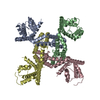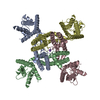+ Open data
Open data
- Basic information
Basic information
| Entry | Database: PDB / ID: 8vc4 | ||||||
|---|---|---|---|---|---|---|---|
| Title | Voltage gated potassium ion channel Kv1.2 in Sodium | ||||||
 Components Components | Potassium voltage-gated channel subfamily A member 2 | ||||||
 Keywords Keywords | MEMBRANE PROTEIN / Ion Channel / Sodium bound | ||||||
| Function / homology |  Function and homology information Function and homology informationoptic nerve structural organization / Voltage gated Potassium channels / potassium channel complex / voltage-gated monoatomic ion channel activity involved in regulation of postsynaptic membrane potential / regulation of circadian sleep/wake cycle, non-REM sleep / paranodal junction / potassium ion export across plasma membrane / corpus callosum development / voltage-gated monoatomic ion channel activity involved in regulation of presynaptic membrane potential / delayed rectifier potassium channel activity ...optic nerve structural organization / Voltage gated Potassium channels / potassium channel complex / voltage-gated monoatomic ion channel activity involved in regulation of postsynaptic membrane potential / regulation of circadian sleep/wake cycle, non-REM sleep / paranodal junction / potassium ion export across plasma membrane / corpus callosum development / voltage-gated monoatomic ion channel activity involved in regulation of presynaptic membrane potential / delayed rectifier potassium channel activity / axon initial segment / optic nerve development / juxtaparanode region of axon / outward rectifier potassium channel activity / neuronal cell body membrane / regulation of dopamine secretion / lamellipodium membrane / action potential / voltage-gated potassium channel activity / kinesin binding / neuronal action potential / voltage-gated potassium channel complex / axon terminus / potassium ion transmembrane transport / sensory perception of pain / calyx of Held / protein homooligomerization / cerebral cortex development / lamellipodium / presynaptic membrane / perikaryon / postsynaptic membrane / endosome / axon / dendrite / endoplasmic reticulum membrane / glutamatergic synapse / membrane / plasma membrane Similarity search - Function | ||||||
| Biological species |  | ||||||
| Method | ELECTRON MICROSCOPY / single particle reconstruction / cryo EM / Resolution: 3.17 Å | ||||||
 Authors Authors | Wu, Y. / Sigworth, F.J. | ||||||
| Funding support |  United States, 1items United States, 1items
| ||||||
 Citation Citation |  Journal: bioRxiv / Year: 2024 Journal: bioRxiv / Year: 2024Title: Cryo-EM structures of Kv1.2 potassium channels, conducting and non-conducting. Authors: Yangyu Wu / Yangyang Yan / Youshan Yang / Shumin Bian / Alberto Rivetta / Ken Allen / Fred J Sigworth /  Abstract: We present near-atomic-resolution cryo-EM structures of the mammalian voltage-gated potassium channel Kv1.2 in open, C-type inactivated, toxin-blocked and sodium-bound states at 3.2 Å, 2.5 Å, 3.2 ...We present near-atomic-resolution cryo-EM structures of the mammalian voltage-gated potassium channel Kv1.2 in open, C-type inactivated, toxin-blocked and sodium-bound states at 3.2 Å, 2.5 Å, 3.2 Å, and 2.9Å. These structures, all obtained at nominally zero membrane potential in detergent micelles, reveal distinct ion-occupancy patterns in the selectivity filter. The first two structures are very similar to those reported in the related Shaker channel and the much-studied Kv1.2-2.1 chimeric channel. On the other hand, two new structures show unexpected patterns of ion occupancy. First, the toxin α-Dendrotoxin, like Charybdotoxin, is seen to attach to the negatively-charged channel outer mouth, and a lysine residue penetrates into the selectivity filter, with the terminal amine coordinated by carbonyls, partially disrupting the outermost ion-binding site. In the remainder of the filter two densities of bound ions are observed, rather than three as observed with other toxin-blocked Kv channels. Second, a structure of Kv1.2 in Na solution does not show collapse or destabilization of the selectivity filter, but instead shows an intact selectivity filter with ion density in each binding site. We also attempted to image the C-type inactivated Kv1.2 W366F channel in Na solution, but the protein conformation was seen to be highly variable and only a low-resolution structure could be obtained. These findings present new insights into the stability of the selectivity filter and the mechanism of toxin block of this intensively studied, voltage-gated potassium channel. | ||||||
| History |
|
- Structure visualization
Structure visualization
| Structure viewer | Molecule:  Molmil Molmil Jmol/JSmol Jmol/JSmol |
|---|
- Downloads & links
Downloads & links
- Download
Download
| PDBx/mmCIF format |  8vc4.cif.gz 8vc4.cif.gz | 261.4 KB | Display |  PDBx/mmCIF format PDBx/mmCIF format |
|---|---|---|---|---|
| PDB format |  pdb8vc4.ent.gz pdb8vc4.ent.gz | 163.1 KB | Display |  PDB format PDB format |
| PDBx/mmJSON format |  8vc4.json.gz 8vc4.json.gz | Tree view |  PDBx/mmJSON format PDBx/mmJSON format | |
| Others |  Other downloads Other downloads |
-Validation report
| Summary document |  8vc4_validation.pdf.gz 8vc4_validation.pdf.gz | 1.2 MB | Display |  wwPDB validaton report wwPDB validaton report |
|---|---|---|---|---|
| Full document |  8vc4_full_validation.pdf.gz 8vc4_full_validation.pdf.gz | 1.2 MB | Display | |
| Data in XML |  8vc4_validation.xml.gz 8vc4_validation.xml.gz | 41.1 KB | Display | |
| Data in CIF |  8vc4_validation.cif.gz 8vc4_validation.cif.gz | 60.2 KB | Display | |
| Arichive directory |  https://data.pdbj.org/pub/pdb/validation_reports/vc/8vc4 https://data.pdbj.org/pub/pdb/validation_reports/vc/8vc4 ftp://data.pdbj.org/pub/pdb/validation_reports/vc/8vc4 ftp://data.pdbj.org/pub/pdb/validation_reports/vc/8vc4 | HTTPS FTP |
-Related structure data
| Related structure data |  43133MC  8vc3C  8vc6C  8vchC M: map data used to model this data C: citing same article ( |
|---|---|
| Similar structure data | Similarity search - Function & homology  F&H Search F&H Search |
- Links
Links
- Assembly
Assembly
| Deposited unit | 
|
|---|---|
| 1 |
|
- Components
Components
| #1: Protein | Mass: 60591.570 Da / Num. of mol.: 4 Source method: isolated from a genetically manipulated source Source: (gene. exp.)   Komagataella pastoris (fungus) / References: UniProt: P63142 Komagataella pastoris (fungus) / References: UniProt: P63142 |
|---|
-Experimental details
-Experiment
| Experiment | Method: ELECTRON MICROSCOPY |
|---|---|
| EM experiment | Aggregation state: PARTICLE / 3D reconstruction method: single particle reconstruction |
- Sample preparation
Sample preparation
| Component | Name: Voltage gated potassium channel Kv1.2 in Sodium / Type: CELL / Entity ID: all / Source: RECOMBINANT |
|---|---|
| Source (natural) | Organism:  |
| Source (recombinant) | Organism:  Komagataella pastoris (fungus) / Strain: SMD1168 Komagataella pastoris (fungus) / Strain: SMD1168 |
| Buffer solution | pH: 7.4 |
| Specimen | Conc.: 0.1 mg/ml / Embedding applied: NO / Shadowing applied: NO / Staining applied: NO / Vitrification applied: YES |
| Vitrification | Cryogen name: ETHANE |
- Electron microscopy imaging
Electron microscopy imaging
| Experimental equipment |  Model: Titan Krios / Image courtesy: FEI Company |
|---|---|
| Microscopy | Model: FEI TITAN KRIOS |
| Electron gun | Electron source:  FIELD EMISSION GUN / Accelerating voltage: 300 kV / Illumination mode: FLOOD BEAM FIELD EMISSION GUN / Accelerating voltage: 300 kV / Illumination mode: FLOOD BEAM |
| Electron lens | Mode: BRIGHT FIELD / Nominal defocus max: 2000 nm / Nominal defocus min: 1000 nm |
| Image recording | Electron dose: 50 e/Å2 / Film or detector model: GATAN K3 (6k x 4k) |
- Processing
Processing
| EM software | Name: PHENIX / Version: 1.21rc1_5107: / Category: model refinement | ||||||||||||||||||||||||
|---|---|---|---|---|---|---|---|---|---|---|---|---|---|---|---|---|---|---|---|---|---|---|---|---|---|
| CTF correction | Type: NONE | ||||||||||||||||||||||||
| 3D reconstruction | Resolution: 3.17 Å / Resolution method: FSC 0.143 CUT-OFF / Num. of particles: 336318 / Symmetry type: POINT | ||||||||||||||||||||||||
| Refinement | Cross valid method: NONE Stereochemistry target values: GeoStd + Monomer Library + CDL v1.2 | ||||||||||||||||||||||||
| Displacement parameters | Biso mean: 80.01 Å2 | ||||||||||||||||||||||||
| Refine LS restraints |
|
 Movie
Movie Controller
Controller






 PDBj
PDBj





